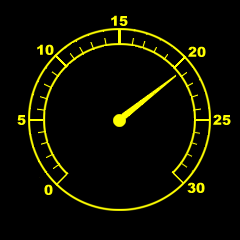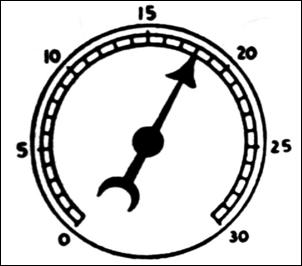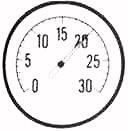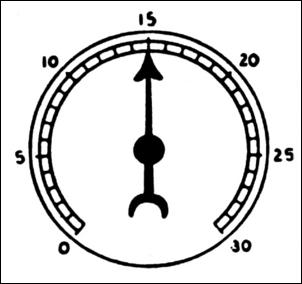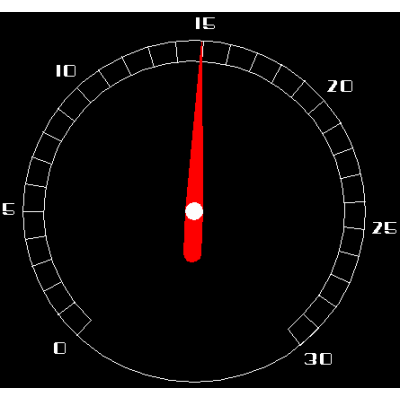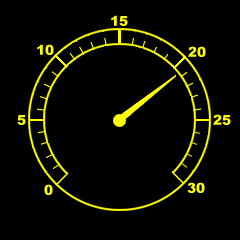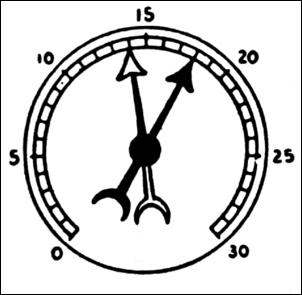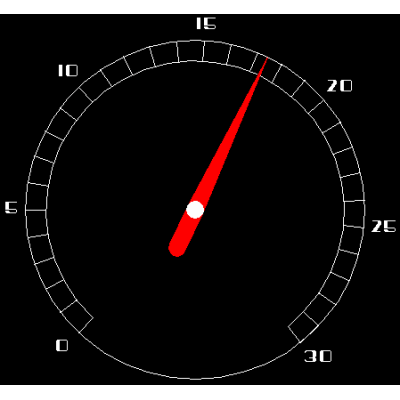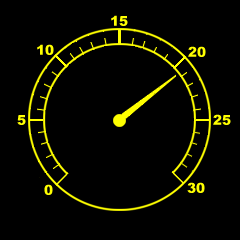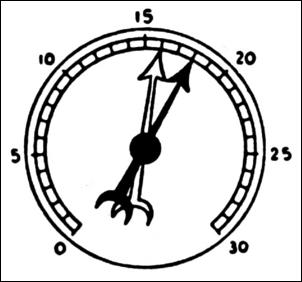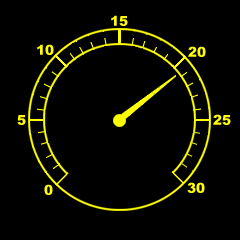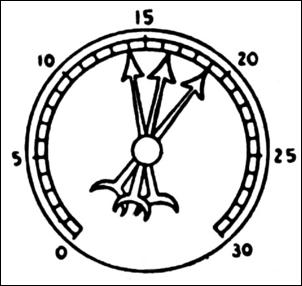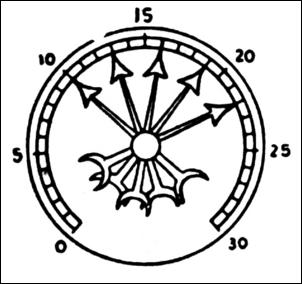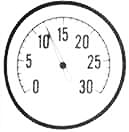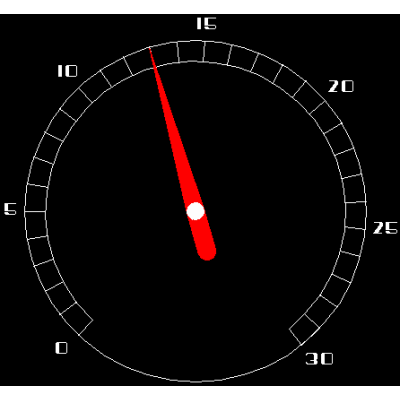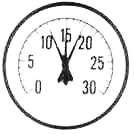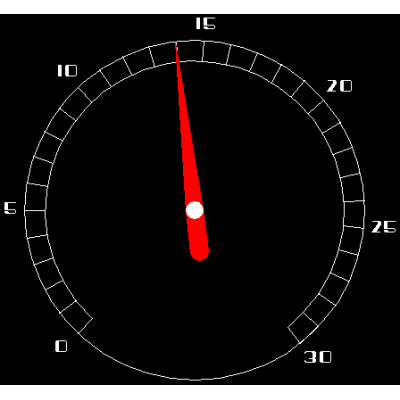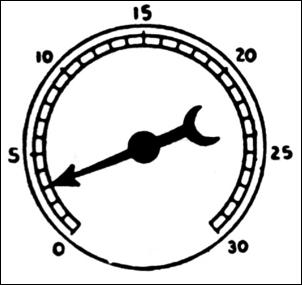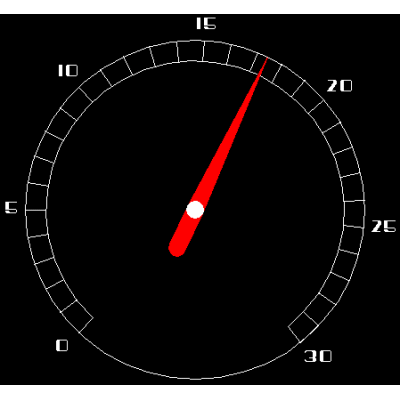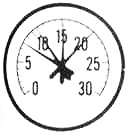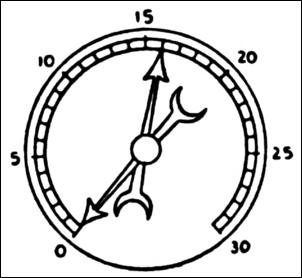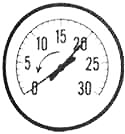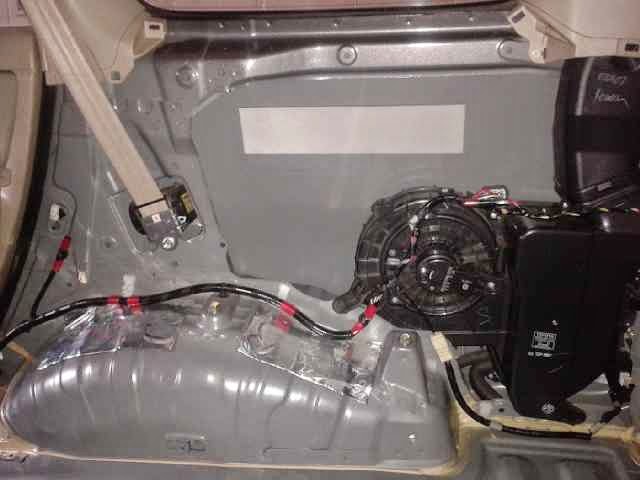Membaca Vacuum Gauge bagian 2

lanjutan dari bagian 1
Dari sumber di atas newbie dapati kemiripan & perbedaan pembacaan; Newbie coba 'copy paste' dan kompilasi redundant - acak kadut untuk engine diagnostic di bawah ini. Perlu diingat bahwa pembacaan di sini yang terpenting adalah 'action' dari jarumnya jauh lebih penting ketimbang angka yang ditunjuk oleh jarumnya.
Leaking Piston Rings / Poor Ring or Poor Oil (at idle)
Leaking Piston Rings / Poor Ring or Poor Oil (when Throttle Snapped Open and Closed)
Sticky Valve
Burn or Leaking Valve
Worn or Loose Valve Guides
Weak Valve Spring
Valve Timing and Ignition Timing
Carburetor or Mixture Adjustment
Spark Plug Gap
Leaking Intake / Vacuum
Leaky Head Gasket
Clogged PCV
Ignition Problem
-- end --
sumber :
gambar 1 - yang penting bukan keakuratan angka yang ditunjuk
gambar 2 - yang penting adalah action dari jarum
Jangan bingung dengan arah jam karena ada angka Nol yang di knan dan ada yang di kiri (berlawanan / searah jarum jam) !!!
Normal Engine (at Idle)
- On a normal running engine, the needle should remain steady anywhere between 17 and 21 in-Hg while idling as seen below.
gambar 3 - Normal Idle
- When the engine is healthy and working correctly, at idle the needle of the gauge should be steady and within the range of 17 – 22 inches of mercury.
gambar 6 - Normal Idle
- Steady needle : Normal reading (usually 17-22" Hg. in stock engines) Race engines vary "a lot" and in most cases will be considerably less.
gambar 7 - Normal Idle
Normal Engine (when Throttle Snapped Open and Closed)
- When the throttle is suddenly opened and closed, the gauge should behave as seen on below.
gambar 8 - Normal - gas full dan lepas
- When throttle is opened and closed rapidly needle falls to 2 and swings back to 24 or 25, falling back to normal idle reading Indicates rings and valves ok
gambar 9 - Normal - gas full dan lepas
- When the accelerator is pressed the reading will drop to below 5 then go to 25 before returning to normal
gambar 10 - Normal - gas full dan lepas
- Vacuum should drop to 3 and then momentarily climb to 25 – 28 before settling back at the previous value. This indicates that the valves and rings are OK.
gambar 11 - Normal - gas full dan lepas
Leaking Piston Rings / Poor Ring or Poor Oil (at idle)
- The readings will be similar to a normal engine, with the exception that all readings will fall by 3-5 in-Hg.
{no image}
- Motor idling, hand reading steadily, but 2-4 points lower than normal. This may also indicate poor or contaminated engine oil, late ignition timing, a leaky vacuum hose and a leaking gasket between the intake and carb or throttle body.
gambar 12 - Leak piston rings / poor oil
- A reading lower than normal could indicate worn piston rings
gambar 13 - Worn piston rings
- Poor Rings or Oil at Idle : The needle will be steady but the reading will be lower than normal.
gambar 14 - poor rings or oil at idle
- Low, though steady reading : Late timing, low compression, sticking throttle valve, carb or manifold vacuum leak (remember most fast engines with a big cam and a tight centerline and high overlap will be naturally low ... you must decide your baseline vacuum reading)
{no image}
Leaking Piston Rings / Poor Ring or Poor Oil (when Throttle Snapped Open and Closed)
- Leaking Piston Rings : The readings will be similar to a normal engine, with the exception that all readings will fall by 3-5 in-Hg.
gambar 15 - Leaking piston rings
- POOR RINGS/POOR OIL : When throttle is opened and closed rapidly needle falls to 0 and rises to only 24 or less.
gambar 16 - poor rings / poor oil
- Poor Rings or Oil when Throttle Snapped Open and Closed : Vacuum will drop to near zero and then momentarily climb to about 22 before settling back to previous value.
gambar 17 - Poor Rings or Oil ( Throttle Snapped Open and Closed)
Sticky Valve
- An intermittent drop of 3-4 in-Hg indicates sticking valves as shown below
gambar 18 - Sticking Valve
- STICKING VALVE : Needle drops occasionally about 4 points at idle speed. May also be caused by ignition misfire. Read the spark plugs.
gambar 19 - Sticking Valve
- When the reading drops 3 to 5 then this could indicate a sticking valve
gambar 20 - Sticking Valve
- Sticky Valve : The needle will drop occasionally about 4 inches of mercury from its normal idling reading.
gambar 21 - Sticky Valve
- Intermittent fluctuation at idle : Ignition miss, sticking valves, lifter bleeding off (hydraulic), or just a BIG camshaft.
gambar 22 - Sticking Valve
Burn or Leaking Valve
- If the needle vibrates as the engine is accelerated, there may be a burned or leaking valve. This is shown by the image below.
gambar 23 - burn or leaking valve
- BURNT VALVE : Needle drops regularly by several points at idle speed.
gambar 24 - burnt valve
- LEAKY VALVE : Needle drops 2-4 points when valve should close. short circuiting individual spark plugs will indicate cylinder in which the valve is defective, when engine idling.
gambar 25 - Leaky valve
- When the reading drops by more than 7 it could indicate a burnt valve when that cylinder operates
gambar 26 - burnt valve
- When the reading drops 3 to 4 it could be due to a leaky valve whenever that valve operates
gambar 27 - leaky valve
- Burnt Valve : The needle will regularly drop by a greater amount than with a sticky valve – eg 6 inches of mercury.
gambar 28 - Burnt valve
- Leaky Valve : The needle rapidly drops two or more inches each time the valve should be closed. May also indicate a misfire.
gambar 29 - Leaky valve
- Steady, but needle drops regularly : Burnt valve or incorrect valve setting (too tight), "needle will fall when bad valve operates"
- Fluctuating needle as RPM increases : Ignition miss, blown head gasket, leaking valve or weak or broken valve spring
gambar 30 - burnt or leaking valve
Worn or Loose Valve Guides
- When the needle vibrates rapidly at idle speed, the intake valve guides are worn. The image below shows this possibility.
gambar 31 - valve guides are worn
- WORN VALVE GUIDES : Rapid fluctuation of needle between 17 and 21, when engine idling. Exhaust smoke may also be present. If engine speed goes up with fluctuation, check for a leaking intake manifold gasket, head gasket, weak valve springs, burned valves, or ignition misfire.
gambar 32 - worn valve guides
- When the needle vibrates between 14 and 19 it could indicate loose valve guides.
gambar 33 - loose valve guides
- Loose Valve Guides : Fast vibration of the needle between 14 and 19 inches of mercury.
gambar 34 - loose valve guides
- Excessive vibration that steadies as RPM increases : Worn valve guides.
gambar 35 - worn out valve guides
Weak Valve Spring
- If the needle vibrates when the engine is accelerated, there may be one or more weak valve springs.
{no image}
- WORN VALVE GUIDES : Rapid fluctuation of needle between 17 and 21, when engine idling. Exhaust smoke may also be present. If engine speed goes up with fluctuation, check for a leaking intake manifold gasket, head gasket, weak valve springs, burned valves, or ignition misfire.
- Wide variations could indicate that there are weak or broken valve springs, increases with engine speed.
gambar 36 - weak or broken valve springs
- Weak Valve Springs : When revving the engine hard, needle varies between 14 – 22 inches of mercury. As rpm increases, a wider variation occurs in needle movement.
gambar 37 - Weak Valve Springs
- Fluctuating needle as RPM increases : Ignition miss, blown head gasket, leaking valve or weak or broken valve spring.
Valve Timing and Ignition Timing
- If the engine compression is known to be good, but the gauge reads lower than it should, the ignition timing may be slow. Test the timing with your timing light. Lower than normal readings can sometimes indicate slow valve timing.
gambar 38 - SLOW TIMING
- POOR RINGS : Motor idling, hand reading steadily, but 2-4 points lower than normal. This may also indicate poor or contaminated engine oil, late ignition timing, a leaky vacuum hose and a leaking gasket between the intake and carb or throttle body.
- When the reading is between 14 and 8 this could indicate incorrect valve timing.
gambar 39 - Incorrect valve timing
- A reading of 13 to 16 could indicate incorrect ignition timing.
gambar 40 - Incorrect ignition timing
- If normal is 20 and reading is 14 check timing as spark could be retarded.
gambar 41 - spark timing could be retarded
- Leaky Intake System : Needle reads low (eg below 5 inches of mercury) at idle. May also indicate late ignition timing or incorrect camshaft timing.
- Low, though steady reading : Late timing, low compression, sticking throttle valve, carb or manifold vacuum leak (remember most fast engines with a big cam and a tight centerline and high overlap will be naturally low ... you must decide your baseline vacuum reading)
gambar 42 - incorrect valve timing
Carburetor or Mixture Adjustment
- When the needle fluctuates slowly, the problem is carburetor adjustment.
gambar 43 - carburetor adjustment
- If the needle moves slowly through a wide ranger, check for a clogged PCV system, incorrect idle fuel mixture or intake manifold gasket leaks.
{no image}
- If the carbs are not well adjusted then the reading could drift between 12 and 16.
gambar 44 - carbs are not well adjusted
- Clogged PCV or Intake Manifold Leaks : Needle moves slowly through a wide range of readings. Also check idle air/fuel ratio.
- Drifting needle : Improper carb setting or minor vacuum leak
gambar 45 - mixture adjustment needed
Spark Plug Gap
- A fluctuating reading over a very narrow range usually indicates than the spark plug gaps are too close.
gambar 46 - Spark plug gap
- When the reading drifts slowly between 14 and 16 it could be the plug gaps are too close or the contact breaker points are not synchronized.
gambar 47 - plug gap are too close
Leaking Intake / Vacuum
- A steady reading, but a lower than normal reading indicates an intake manifold leak. Make sure that the accessories that run on vacuum are disconnected, including the brake booster. Measure again to see if there is any improvement.
gambar 48 - leaking intake
- A low reading of below 5 could indicate a leaky manifold, manifold gasket or carb gasket.
gambar 49 - leaky manifold
- Leaky Intake System : Needle reads low (eg below 5 inches of mercury) at idle. May also indicate late ignition timing or incorrect camshaft timing.
gambar 50 - leaky intake system
- Low, though steady reading : Late timing, low compression, sticking throttle valve, carb or manifold vacuum leak (remember most fast engines with a big cam and a tight centerline and high overlap will be naturally low ... you must decide your baseline vacuum reading)
Leaky Head Gasket
- If the needle fluctuates at idle between high and low readings, the cylinder head gasket has probably been blown between two adjacent cylinders. Make a compression test.
gambar 51 - Leaking Head Gasket
- If there is a large fluctuation of the needle, perform a compression test to look for a weak or dead cylinder or a blown head gasket.
{no image}
- Wide variations could be a blown head gasket.
gambar 52 - blown head gasket
- Leaky Head Gasket Between Cylinders : Needle floats regularly between 5 and 19 inches of mercury. May also indicate intake manifold gasket leak at an intake port or a faulty injector.
gambar 53 - Leaky head gasket between cylinders
- Fluctuating needle as RPM increases : Ignition miss, blown head gasket, leaking valve or weak or broken valve spring.
gambar 54 - Blown head gasket
Clogged PCV
- If the needle moves slowly through a wide ranger, check for a clogged PCV system, incorrect idle fuel mixture or intake manifold gasket leaks.
{no image}
- Clogged PCV or Intake Manifold Leaks : Needle moves slowly through a wide range of readings. Also check idle air/fuel ratio.
Exhaused
- After a normal reading which then drops to 0 could indicate a blocked exhaust.
gambar 56 - blocked exhaust
- Blocked Exhaust : High reading at first but suddenly returns to zero then builds slowly back to about 16 inches of mercury.
gambar 57 - Blocked Exhaust
Ignition Problem
- A slight needle fluctuation, say one inch up or down, may mean ignition problems. Check all the usual tune up items.
{no image}
- An occasional drop as the cylinder fires could indicate that this cylinders plug is not firing or open valve
gambar 59 - cylinder plug is not firing
- Fluctuating needle as RPM increases : Ignition miss, blown head gasket, leaking valve or weak or broken valve spring
{no image}
-- end --


